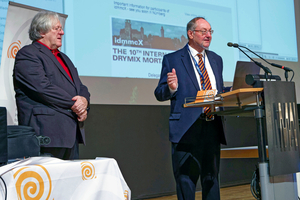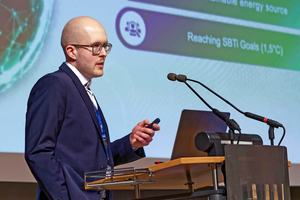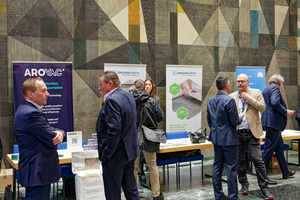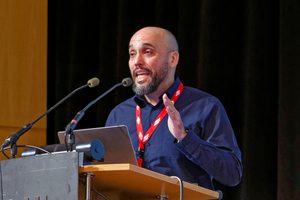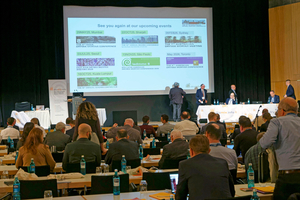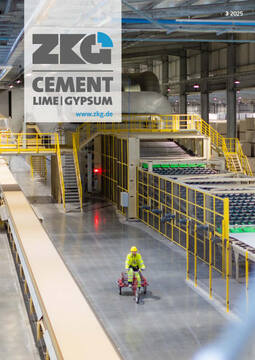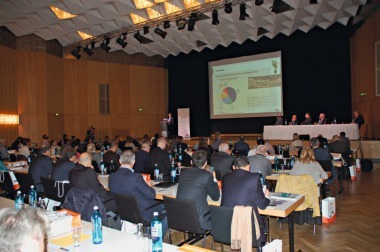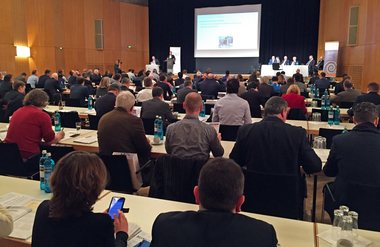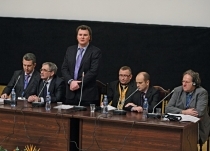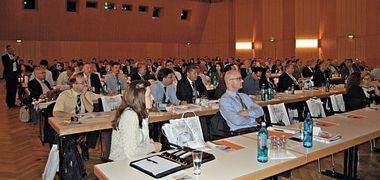idmmcX: The International Drymix Mortar Conference celebrates its 10th anniversary
Every two years, at the invitation of Ferdinand Leopolder, founder of drymix.info, international experts in the field of drymix mortar come together in the Kleine Meistersingerhalle in Nuremberg to discuss the latest findings and developments in the industry. On March 24, 2025, the International Drymix Mortar Conference celebrated its 10th anniversary - and set a new attendance record with over 220 participants. Ferdinand Leopolder is delighted: “Next time we might have to look for a larger venue.” While the breaks in the program offered the opportunity to exchange ideas with the exhibiting companies, the speakers presented 21 different topics as part of the conference. An overview.
From a better CO2 footprint to sustainable packaging solutions
The first block of presentations, moderated by idmmc-Technical Chairman Prof Dr Johann Plank, TUM, featured speakers from Wacker Chemie, Actemium, Blackburn, Timab and Bischof+Klein.
Dr Klas Sorger, Wacker Chemie, presented the topic “Improving the Carbon Footprint of Drymix Mortars: CEM II Cememts in Tile Adhesives” and spoke about challenges and opportunities. With the aim of reducing their carbon footprint, more and more cement plants are switching their production to Portland composite cements (CEM II). At the same time, manufacturers of tile adhesives and other drymix mortars would also have to change their production and convert formulas based on classic Portland cement (CEM I). Sorger presented research results from extensive studies conducted by Wacker Chemie.
Nicolas Genevrier, Actemium, spoke about how to “Get the Right Partner for your Major Drymix Plant All Around the World” on the basis of three key points: technical expertise, turnkey solutions and reliability.
Edward Rushworth, Blackburn Chemicals, presented “A Safer Shrinkage Reduction Agent for the Drymix Mortar Industry”. As many chemistries used for shrinkage reduction come with a variety of disadvantages - such as strong odors, compaction during storage, hazards, volatile organic compounds or fossil fuel feedstocks - Blackburn Chemicals has developed a more environmentally friendly and safer new powder SRA (shrinkage reduction agent).
Sticking with the SRA theme, Dr Jacques Jabbour, Timab Magnesium, presented “A Novel Magnesium Oxide Based Shrinkage Reducing Agent for Drymix Mortars”. SRAs are the agent of choice to counteract the breakage of mortar during the curing process - but these are also associated with some disadvantages such as high water consumption, high curing requirements or delayed ettringite reaction. In his presentation, Jabbour introduced a new, customizable magnesium-based shrinkage reduction agent from Timab.
Erik Niehaus and Ingo Schweer, both from Bischof+Klein, concluded the first lecture block with a presentation on “Sustainable Packaging Solutions”. The speakers talked about industrial valve bags and stretchhood films with PCRs (Post-Consumer Recyclates) under the scope of the PPWR regulation.
Lightweight fillers for sustainable mortars and the characterization of reduced clinker tile adhesives formulations
Moderated by Session Chairman Dr Christoph Hahner, transform2innovate, the second block of lectures offered space for presentations by the companies Çimsa, Omya, Mapei, Haver&Boecker, Beumer and Atlas.
To kick off the second series of lectures, the topic “Reducing Carbon Footprints with Innovative Calcium Aluminate Technology in Construction” was presented by Dr Julian Wolf, Çimsa. The low-carbon calcium aluminate-based additive presented, through its 70% mayenite phase composition, enables the reduction of the cement ratio commonly used in ternary system recipes and even has the potential to eliminate this ratio entirely, according to the speaker. This could ensure the use of more sustainable materials in the construction industry on the one hand and reduce the CO2 footprint of the entire value chain on the other.
David Gonzalez Amago, Omya, spoke about “Lightweight Fillers for High Performance and Sustainable Mortars”. By replacing sand with lightweight functional fillers in high-performance mortars, a reduction in weight can be achieved. Amago presented the benefits of using the combination of functional and lightweight fillers in three different drymix mortar applications: 3D construction printing (3DCP), self-levelling underlayments (SLU) and cementious tile adhesives (CTA, here C2TES1).
In the next presentation, Dr Stefano Carrà, Mapei, described the “Analytical and Mechanical Characterization of Reduced Clinker Tile Adhesive Formulations”. While drymix producers represent a minority in the global cement production, Carrà stated, tile adhesive formulations can still embrace solutions devised for lesser CO2 footprint concrete.
“New Solutions to Optimize Your Packing Process” were introduced to the audience by Michael Mestekemper, Haver & Boecker. The company’s PROcheck life cycle approach’s goal is to systematize all instruments and actions with which the efficiency and processes can be monitored at all times.
Following up, Andras Herzog, Beumer, presented the company’s latest innovation on high-speed palletizing and packing for the drymix mortar industry by showing case studies under the title of “Modern Palletizing and Packaging in the Drymix Mortar Industry”.
In the last presentation before the lunch break, Dr Bartosz Michałowski, Atlas, spoke about the “Assessment and Verification of the Constancy of the Performance Properties of CTAs in the Light of the Requirements of EN 12004”. The lecture presented the results of an interlaboratory comparison (ILC) of 14 laboratories for determining the tensile adhesion strength of cementious tile adhesives (CTA) to a concrete substrate.
Very low clinker binders and sustainable construction
The companies Organik Kimya, Ecocem, Sika, Arodo and Imerys presented their topics in the third lecture block under the moderation of Philippe Russo, director at drymix.info.
To begin with, Dr Jean-Yves Petit, Organik Kimya, presented studies on switching from CEM I cements to CEM II A/CEM II B cements or even lower clinker cements, in order to investigate the impact of slower hydration rates and low heat of hydrations at the endues values of CTA mortars, under the title “Switching to Low or Very Low Clinker Content Binders in Cementious Ceramic Tile Adhesives Formulations”.
Dr Yasmine Kaci, Ecocem, spoke about “A Novel Low Carbon High Performance Technology for the Drymix Mortars”. Ecocem has developed and patented a new low carbon technology for use in high performance products such as industrial mortars, ultra-high performance concrete or precast concrete. The presentation showed results of the research done in the Ecocem Research and Innovation Laboratory on low-carbon dry mortars, specifically in low-carbon tile adhesives C2ET with a very low carbon footprint.
Approaches for “Reducing Cement and thus CO2 Using PCE in Sand-Cement Mortars” were introduced by Dr Markus Müller, Sika. According to the speaker, it is possible to reduce cement by 20% and more by using high-performance superplasticizers based on polycarboxylate ethers (PCE), without sacrificing desired mortar properties.
Robert Schmiehusen, Arodo, spoke about the topic of “Protecting Products and the Planet: AROVAC© Vacuuum Technology’s Impact on Suistainable Packaging”. The presentation focused on how AROVAC - ensuring reduced material usage as well as supporting the use of recycled materials - aims at redefining sustainable packaging by enabling processes which conserve precious resources.
Concluding the third round of presentations, Frank Mertes, Imerys, focused on “Pozzolanicity & Special Binders, Toward Sustainable Construction”. In his presentation, the speaker showed that metakaolin - the active ingredient of calcinated clay - is connected with a variety of applicative benefits in drymix mortars with low-carbon footprint, effectively improving their robustness and performance.
Eco-friendly white cement, calcium sulphates and cellulose ether: Finale of the idmmcX
The fourth and final session of the day was hosted by Ferdinand Leopolder. Here, speakers from Oyak Çimento, Concetti, Casea, Calucem as well as Dow got to share their presentations.
Starting the session, Metehan Severoğlu, Oyak Çimento, introduced “A New Generation of Eco-Friendly White Cement for Drymix Mortar Applications”. Oyak Çimento’s new SuperWhite+ Cement, according to the speaker, combines both low carbon demand and the performance needs of drymix mortar producers. A prolonged setting time and open time are some of the other specialities of SuperWhite+ mentioned in the presentation.
Manno Duym, Concetti, spoke about “The Key to Perfect Packaging: Expert Product Analysis”. In his presentation, the speaker analyzed the key factors to consider during a thorough product analysis: product flowability, maximum aeriation level, product behavior as well as particle size distribution/segregation.
Dr Tim Link, Casea, shed light on “Calcium Sulphates for Building Chemistry”. The presentation focussed on calcium sulphates and their associated life cycle assessment data and gave an outlook on the commercial availability of anhydrites from flue gas desulphurization (FGD Gypsum).
The presentation of Dr Florian Hartmann, Calucem, dealt with “Istra 45 Aluminate Cement – Maximizing Cost-Performance in Building Chemistry”. Istra 45, a calcium-aluminate cement (CAC) was compared to other building chemistry-optimized products from the 40 grade and 50 grade ranges in self-levelling application.
As the final presenter of the day, Dr Eduardo Cruz, Dow, lectured on the topic of “Cellulose Ether (CE) and Low Clinker Cement (LCC): How can CE contribute to the Decarbonization Strategy of Mortar Products?” The presentation put in perspective the impact of cellulose ether on C2 CTA (cementious tile adhesives) properties prepared with different types of cement with the aim to minimize disadvantages that come with utilizing low-clinker cement for early strength development and setting.


